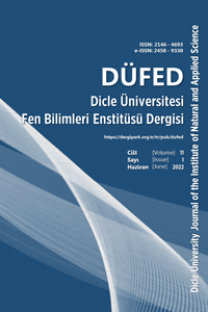Higrotermal Simülasyon Araçlarına Genel Bir Bakış
Hava şartlarına maruz kalan yapı bileşenlerinin higrotermal (nemsel-ısıl) davranışı, bir binanın genel performansının önemli bir parçasını oluşturmaktadır. Nemin tahmin edilmesi ve modellenmesi genellikle karmaşık hesaplamaları içermektedir. Günümüzde, deneysel yöntemler dışında benzetim (simülasyon) programları ile çoğunlukla bina kabuğunun kullanım sırasındaki higrotermal davranışı tahmin edilebilmektedir. Binalarda enerji performansını hesaplamak için kullanılan simülasyon programlarına talep artarken, bina ve kabuğun higrotermal davranışını hesaplayan araçlara olan ilgi ise hala beklenen düzeyde değildir. Bu çalışmanın temel amacı, aktif olarak ulaşılabilen higrotermal analiz programlarını genel olarak irdelemek ve kullanılırlıklarını incelemektir. İlk olarak simülasyon programlarının özellikleri incelenerek genel bir bakış sunulmuştur. Daha sonra bu programların kullanılırlığını analiz etmek için 2001-2019 yılları arasında yayınlanan makaleler elektronik veri tabanlarında incelenmiştir. Tarama sonucunda 8 program tespit edilmiş ve bu programlardan Wufi, DELPHIN ve IDA-ICE araçlarının diğer programlara göre akademik çalışmalarda daha fazla kullanıldığı bulunmuştur. Ayrıca higrotermal analiz program kullanılırlığında azda olsa artış olmasına rağmen istenilen seviyede olmadığı görülmüştür.
Anahtar Kelimeler:
Higrotermal analiz, Simülasyon, Nem
An Overview of Hygrothermal Simulation Tools
Hygrothermal (humidity-thermal) behavior of building components exposed to weather conditions is an important part of the overall performance of a building. Estimating and modeling moisture often involves complex calculations. Today, apart from the experimental methods, mostly the hygrothermal behavior of the building envelope can be estimated with simulation programs. While the demand for simulation programs used to calculate energy performance in buildings is increasing, the interest in tools that calculate the hygrothermal behavior of the building and building envelope is still not at the expected level. The main purpose of this study is to examine the actively accessible hygrothermal analysis programs in general and to examine their usability in literature. Firstly, the simulation programs are overviewed. Later, to analyze the usability of these programs, the articles published between 2001-2019 were examined in electronic databases. As a result of the reviewing, eight programs were identified and it was found that Wufi, DELPHIN and IDA-ICE tools were used more in academic studies than other programs. However, although there was a slight increase in hygrothermal analysis program usage, it was observed that it was not at the desired level.
Keywords:
Hygrothermal analysis, Simulation, Moisture,
___
- Z. Huibo, Y. Hiroshi, “Analysis of indoor humidity environment in Chinese residential buildings”. Building and Environment, vol. 45, pp. 2132–2140, 2010.
- H. M. Künzel, and D. Zirkelbach, “Advances in hygrothermal building component simulation: modelling moisture sources likely to occur due to rainwater leakage”, Journal of Building Performance Simulation, vol. 6, no. 5, pp. 346-35, 2013.
- S. Pallin, P. Boundreaux, S. Shrestha, New. Joshua, Adams. M, State-of-the-Art for Hygrothermal Simulation Tools. (2017). Accessed: Jan. 10, 2021. [Online]. Available: https://info.ornl.gov/sites/publications/Files/Pub73069.pdf
- E. Edis, H. Kuş. “Determination of hygrothermal performance of building envelope by computer simulation”, Gazi Üniv. Müh. Mim. Fak. Der., vol. 29, no. 2, pp. 311-320, 2014.
- A. Ekşi, “Mevcut binaların cephelerinde dıştan ısı yalıtımı uygulamalarının İstanbul’da alanda incelenmesi ve higrotermal performansın benzetimle değerlendirilmesi”, M.S. thesis, Dept. Architecture, Istanbul Technical University, İstanbul, Turkey, 2016.
- S. Chasan, “Dış cephe bitirme sistemlerinde ısı yalıtımının sıcaklık ve nem performansına etkisinin incelenmesi”, M.S. thesis, Dept. Architecture, Trakya University, Edirne, Turkey, 2013.
- J. Straube, and E. F. P. Burnett, “Overview of hygrothermal (HAM) analysis methods”, In: Trechsel HR (ed). ASTM manual 40-moisture analysis and condensation control in building envelopes, pp. 81-89, 1991.
- D. Denyer, D. Tranfield, “Producing a Systematic Review”, The Sage handbook of organizational research methods, pp. 671-689, 2009.
- N. M. M. Ramos, J. M. P. Q. Delgado, E. Barreira, V. P. de. Freitas, “Exterior condensations on façades: numerical simulation of the undercooling phenomenon”, Journal of Building Performance Simulation, vol. 6, no. 5, pp. 337-345, 2013.
- Wufi, What is Wufi. Accessed: Apr. 12, 2020. [Online]. https://wufi.de/en/software/what-is-wufi
- N. M. M. Ramos, J.M.P.Q. Delgado, E. Barreira, V. P. De Freitas, Hygrothermal Numerical Simulation: Application in Moisture Damage Prevention, Numerical Simulations-Examples and Applications in Computational Fluid Dynamics, Lutz Angermann (Ed.), InTech, 2010, pp. 97-122.
- Bsim. Accessed: Sept. 10, 2020. [Online]. https://sbi.dk/bsim/Pages/Kort-om-BSim.aspx
- A. Nicolai, J. Grunewald, J. J. Zhang, “Recent improvements in HAM simulation tools: Delphin 5 / CHAMPS-BES”, in Proceedings of 12th Symposium for Building Physics, 2007, pp. 866-876, Dresden.
- Delphin. Accessed: August. 22, 2020. [Online]. http://bauklimatik-dresden.de/delphin/index.php?aLa=en
- Glasta. Accessed: October. 28, 2020. [Online]. http://www.physibel.be/v0n2gl.htm
- Hamlab. Accessed: November. 18, 2020. [Online]. https://archbpswiki.bwk.tue.nl/bpswiki/index.php/Hamlab
- J. M. P. Q. Delgado, E. Barreira, N.M.M., Ramos, V.P. de Freitas, “Hygrothermal Numerical Simulation Tools Applied to Building Physics”, Springer, London, 2013.
- J. Kurnitski, and M. Vuolle, “Simultaneous calculation of heat, moisture and air transport in a modular simulation environment”, Proceedings of the Estonian Academy of Sciences, vol. 6, no. 1, pp. 25-47, 2000.
- Ida-ice. Accessed: February. 2, 2020. [Online]. https://www.equa.se/en/ida-ice
- Match. Accessed: January. 7, 2020. [Online]. https://match-box.dk/what-is-match/
- A. Pehlevan, Y. Yaşar, S. Maçka, “Higrotermal performans açısından duvar konstrüksiyonu tasarımında bilgisayar modellerinin kullanımı”, X. Ulusal Tesisat Mühendisleri Kongresi, pp. 371-385, İzmir. 2011.
- D. M. Burch and J. Chi, “Moist: A PC program for predicting heat and moisture transfer in building envelopes”, Accessed: June. 12, 2020. [Online]. https://www.nist.gov/system/files/documents/2017/04/28/MoistManual.pdf
- Moist. Accessed: April. 25, 2020. [Online]. https://www.nist.gov/programs-projects/moist
- Wufi. Accessed: March. 25, 2021. [Online]. https://wufi.de/en/software/product-overview/
- ISSN: 2146-4693
- Yayın Aralığı: Yılda 2 Sayı
- Başlangıç: 2012
- Yayıncı: Dicle Üniversitesi
Sayıdaki Diğer Makaleler
Esnek Mekân Anlayışı ile Mekânın Konfora Dönüşümünde Pandemi Hatırlatması
Nasturtium Officinale Ekstraktlarının Antioksidan Aktiviteleri ve Mineral İçeriğinin Araştırılması
Karşılaştırmalı Bir Çalışma: Covid-19 Pandemisinden Sonra Mutluluğu Etkileyen Faktörlerin Analizi
Diyarbakır Parlı (Safa) Medresesi'nin Mekânsal Analizi ve Restorasyon Sonrası Değerlendirmesi
Asetonla Muamele Edilmiş Docetaxelin PC3 ve PNT1A Hücreleri Üzerindeki Sitotoksik Etkisi
Muhammed GÜNGÖREN, Ersin KILINÇ, Zübeyde BAYSAL
2D Konvolüsyonun İşleminin Düşük Maliyetli IP Çekirdek Olarak FPGA Tabanlı Gerçeklenmesi
Hasan MARAL, Mehmet Salih ÖZGÖKÇE
Nanopartikül Takviyeli Polyester Nanokompozitin Termo-Fiziksel Özelliklerinin Karakterizasyonu
